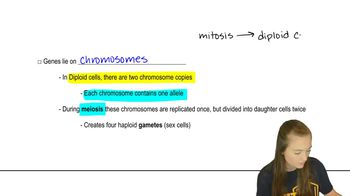Select one of the hereditary conditions from either the RUSP core conditions list or the RUSP list of secondary conditions and do some online research to find the following information: The frequency of the condition in newborn infants (note any populations in which the condition is more frequent)
Table of contents
- 1. Introduction to Genetics51m
- 2. Mendel's Laws of Inheritance3h 37m
- 3. Extensions to Mendelian Inheritance2h 41m
- 4. Genetic Mapping and Linkage2h 28m
- 5. Genetics of Bacteria and Viruses1h 21m
- 6. Chromosomal Variation1h 48m
- 7. DNA and Chromosome Structure56m
- 8. DNA Replication1h 10m
- 9. Mitosis and Meiosis1h 34m
- 10. Transcription1h 0m
- 11. Translation58m
- 12. Gene Regulation in Prokaryotes1h 19m
- 13. Gene Regulation in Eukaryotes44m
- 14. Genetic Control of Development44m
- 15. Genomes and Genomics1h 50m
- 16. Transposable Elements47m
- 17. Mutation, Repair, and Recombination1h 6m
- 18. Molecular Genetic Tools19m
- 19. Cancer Genetics29m
- 20. Quantitative Genetics1h 26m
- 21. Population Genetics50m
- 22. Evolutionary Genetics29m
15. Genomes and Genomics
Genomics and Human Medicine
Problem B.14c
Textbook Question
Select one of the hereditary conditions from either the RUSP core conditions list or the RUSP list of secondary conditions and do some online research to find the following information:
The symptoms and consequences of the condition if it is not treated.
 Verified step by step guidance
Verified step by step guidance1
Identify a hereditary condition from the Recommended Uniform Screening Panel (RUSP) core or secondary conditions list. These are genetic disorders commonly screened for in newborns.
Research the selected condition using reliable genetics and medical resources such as genetics databases, medical journals, or trusted health websites to gather detailed information.
Focus on understanding the symptoms that manifest in individuals affected by the condition, especially those that appear if the condition remains untreated.
Investigate the potential consequences or complications that can arise from the untreated condition, including impacts on development, organ function, or overall health.
Summarize the findings clearly, emphasizing the importance of early detection and treatment to prevent or mitigate these symptoms and consequences.
 Verified video answer for a similar problem:
Verified video answer for a similar problem:This video solution was recommended by our tutors as helpful for the problem above
Video duration:
1mPlay a video:
Was this helpful?
Key Concepts
Here are the essential concepts you must grasp in order to answer the question correctly.
Newborn Screening and the RUSP
The Recommended Uniform Screening Panel (RUSP) is a list of core and secondary conditions that newborns are routinely screened for in the United States. These conditions are selected based on their severity, treatability, and the availability of effective screening tests. Understanding the RUSP helps identify which hereditary conditions are prioritized for early detection to prevent serious health outcomes.
Recommended video:
Guided course

History and Experiments
Hereditary Conditions and Genetic Inheritance
Hereditary conditions are genetic disorders passed from parents to offspring through genes. These conditions can be inherited in various patterns such as autosomal dominant, autosomal recessive, or X-linked. Recognizing the inheritance pattern is essential for understanding the risk of occurrence and the biological basis of the condition.
Recommended video:
Guided course

Diploid Genetics
Symptoms and Consequences of Untreated Genetic Disorders
Many hereditary conditions cause specific symptoms and health problems that worsen if untreated. Early diagnosis through newborn screening allows timely intervention to prevent severe consequences like developmental delays, organ damage, or death. Knowing the untreated progression highlights the importance of screening and treatment.
Recommended video:
Guided course

Descriptive Genetics

 6:51m
6:51mWatch next
Master Human Genome Composition with a bite sized video explanation from Kylia
Start learningRelated Videos
Related Practice
Textbook Question
358
views
